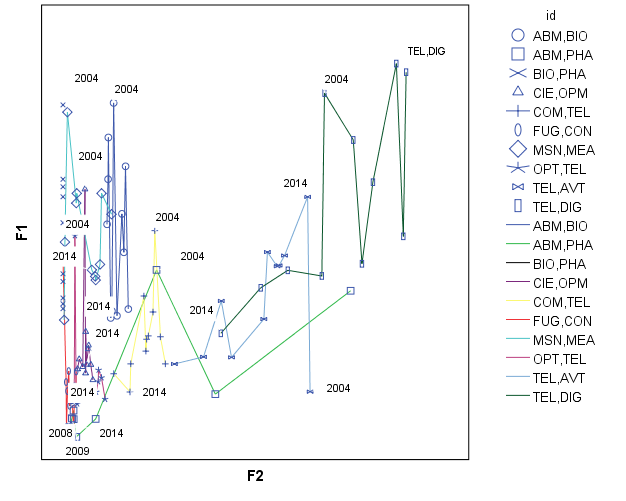 PDF(2136 KB)
PDF(2136 KB)


Analysis of Directed Technological Cross Impact Based on the Patent Co-classification
Li Ruixi, Chen Xiangdong, Cui Yunxia, Cui Caixia
Knowledge Management Forum ›› 2018, Vol. 3 ›› Issue (3) : 160-171.
 PDF(2136 KB)
PDF(2136 KB)
 PDF(2136 KB)
PDF(2136 KB)
Analysis of Directed Technological Cross Impact Based on the Patent Co-classification
 ,
,
 ,
,
 ,
,

[Purpose/significance] It is different from the existing research literatures which focus on the technical relationships in specific technical fields, this paper aims at analyzing and predicting the directional cross impacts among various technologies and providing strategic support for the development of target technology and forecasting technological progress. [Method/process] Using the patent co-classification data of 35 technical fields in China, this paper calculated the directed cross impact values between 35 technical areas based on the patent cross impact analysis methods of Choi and others. Then, according to the impact value, the technical pairs were grouped, and cross impact network was built and changes of cross impact was analyzed. [Result/conclusion] There exists a high proportion of bias and one-way technology impact in the whole technology fields. Food chemistry (FOC) is the most influential technical field. Measurement (MEA) in the instrument field, electrical machinery, equipment, energy (EAE) and computer technology (COM) in the electrical engineering field, as well as basic materials chemistry (BMC) and material, metallurgy (MAM) in chemistry field are the core technology fields, locating at the core of the network.

patent co-classification / technical field / directed cross impact
| [1] |
SCHULER A, THOMPSON WA, VERTINSKY I, et al.Cross impact analysis of technological innovation and development in the softwood lumber industry in Canada: a structural modeling approach[J]. IEEE transactions onengineeringmanagement,1991,38 (3): 224–236.
|
| [2] |
BLANNING R W, REINIG B A. Cross-impact analysis using group decision support systems: an application to the future of Hong Kong[J]. Futures, 1999, 31(1): 39-56.
|
| [3] |
VILLACORTA P J, MASEGOSA A D, CASTELLANOS D, et al. A new fuzzy linguistic approach to qualitative cross impact analysis[J]. Applied soft computing, 2014, 24(11): 19-30.
|
| [4] |
CHOI C, KIM S, PARK Y. A patent-based cross impact analysis for quantitative estimation of technological impact: the case of information and communication technology[J]. Technological forecasting and social change, 2007, 74(8): 1296-1314.
|
| [5] |
THORLEUCHTER D, VAN DEN POEL D,NZIE A. A compared R&D-based and patent-based cross impact analysis for identifying relationships between technologies[J]. Technological forecasting & social change, 2010, 77(7):1037-1050.
|
| [6] |
KIM C, LEE H, SEOL H, et al. Identifying core technologies based on technological cross-impacts: an association rule mining (ARM) and analytic network process (ANP) approach[J].Expert systems with applications,2011,38(10): 12559-12564.
|
| [7] |
马荣康,刘凤朝. 基于专利交互影响分析的纳米技术发展模式国际比较[J]. 中国软科学, 2012(12):49-58.
|
| [8] |
秦立芳. 基于专利交叉影响法的NBI会聚趋势研究[D]. 北京:北京工业大学, 2013.
|
| [9] |
GAUCH S, BLIND K. Technological convergence and the absorptive capacity of standardization[J]. Technological forecasting and social change, 2015, 91(2): 236-249.
|
| [10] |
周磊,杨威.基于专利IPC的技术知识流网络挖掘[J].现代情报,2016, 36(1):45-50.
|
| [11] |
黄斌, 黄鲁成, 吴菲菲,等. 基于专利交叉影响分析法的技术影响关系研究[J]. 科技管理研究, 2015, 35 (15):147-151.
|
| [12] |
BRESCHI S, LISSONI F, MALERABA F. Knowledge-relatedness in firm technological diversification[J]. Research policy, 2003, 32(1): 69–87.
|
| [13] |
LIM H, PARK Y. Identification of technological knowledge intermediaries[J]. Scientometrics, 2010, 84(3): 543-561.
|
| [14] |
PARK H, YOON J. Assessing coreness and intermediarity of technology sectors using patent co-classification analysis: the case of Korean national R&D[J]. Scientometrics, 2014, 98(2): 853-890.
|
| [15] |
李蓓,陈向东. 基于专利合作网络的我国中药合作创新研究[J].中国中药杂志,2015,40(6):1212-1218.
|
李瑞茜: 构思论文、查找处理数据并撰写论文;
陈向东: 提出有益的论文修改建议;
崔云霞: 查找专利数据;
崔彩霞: 查找专利数据。
/
| 〈 |
|
〉 |